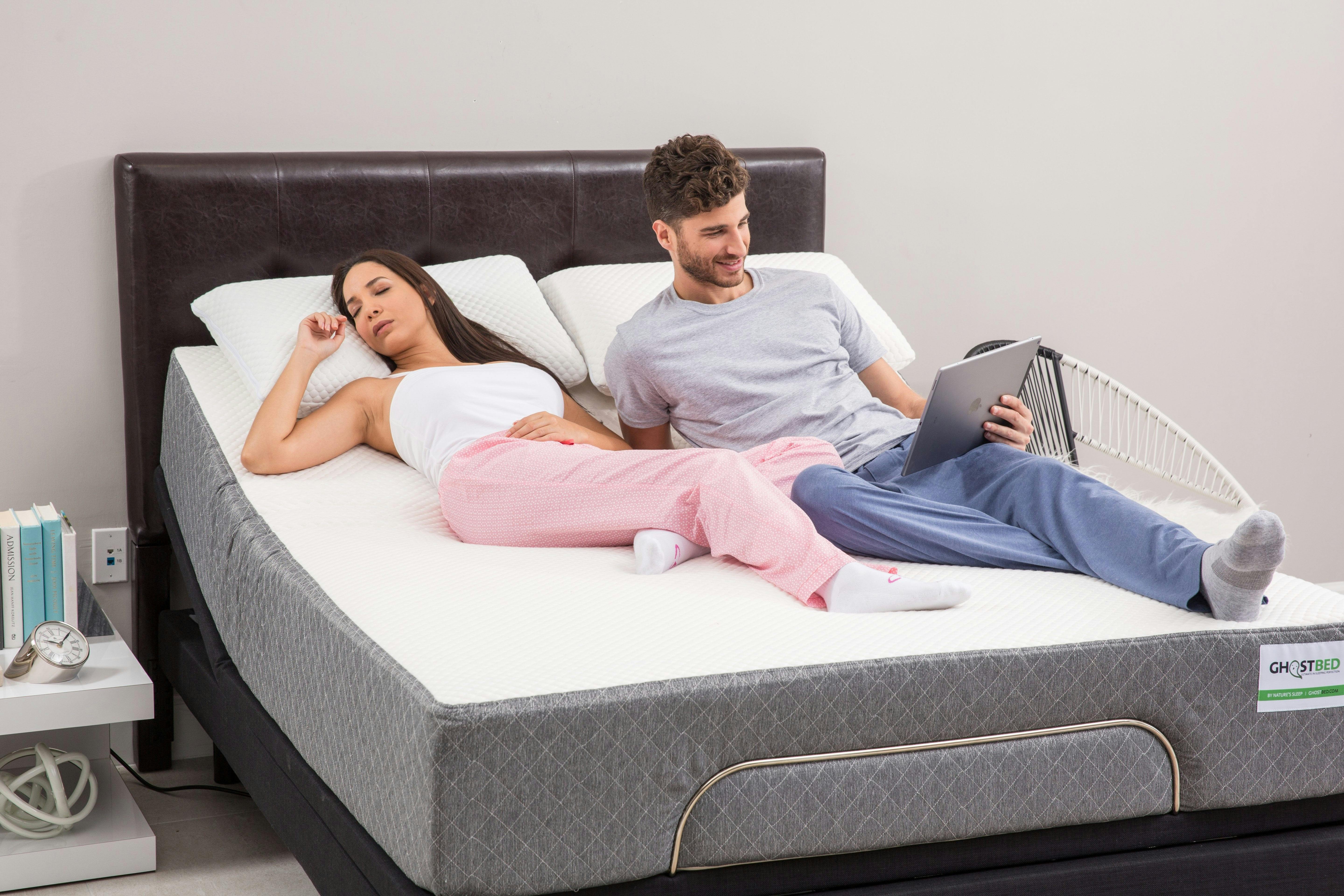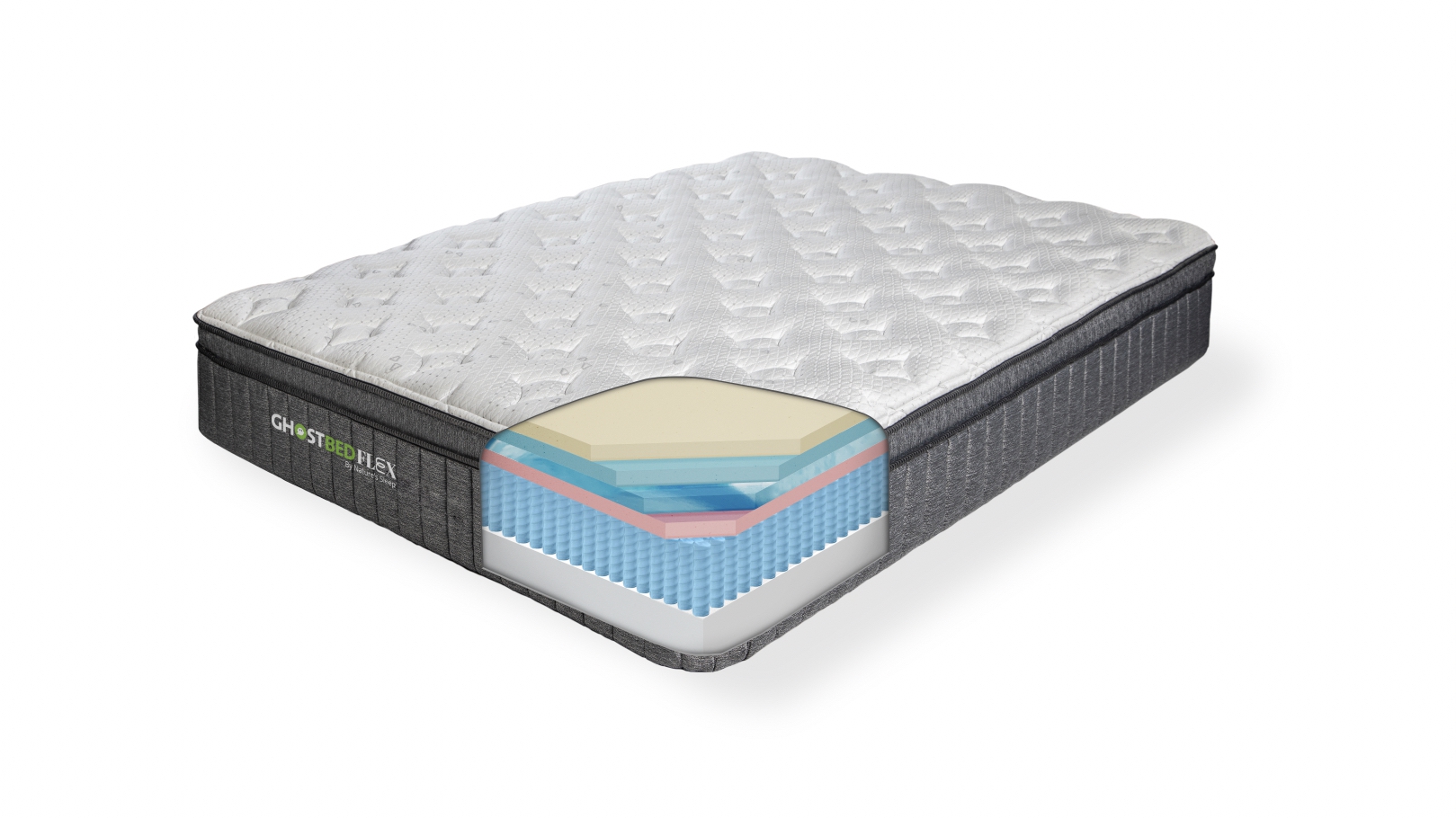Guide: The Best Mattress for Fibromyalgia (+ Tips for Great Sleep)
Last Updated on April 20, 2024
by Marc Werner, Founder - GhostBed
Is your fibromyalgia keeping you up at night? You’re not alone. It’s common for fibromyalgia sufferers to experience insomnia, frequent waking during sleep and horrible stiffness in the morning.
Fortunately, the right mattress—when coupled with a treatment plan from your doctor—can help you get the quality sleep you need.
Overview: Best Mattress for Fibromyalgia
Our pick for the best mattress for fibromyalgia is a high-quality hybrid mattress with a universal feel (not too soft, not too firm), excellent edge support and cooling elements. The key is finding a mattress with excellent support and contouring for your pressure points, which can help eliminate pain and discomfort.

I. How Does Fibromyalgia Affect Sleep?
II. The Best Sleeping Positions for Fibromyalgia
III. Other Tips for Sleeping With Fibromyalgia
IV. Fibromyalgia Sleeping FAQs
V. GhostBed’s Mattress Pick for Fibromyalgia
I. How Does Fibromyalgia Affect Sleep?
Fibromyalgia is a chronic disorder that causes muscle pain, joint pain and stiffness throughout the body. It’s commonly categorized as an autoimmune disorder, although this isn’t actually correct. However, the symptoms may overlap or run concurrently with autoimmune disorders like rheumatoid arthritis and hypothyroidism.
Doctors aren’t sure what causes fibromyalgia, but some believe it’s due to a glitch in the way the brain processes pain. Possible triggers include genetics, stress (including PTSD) and physical or emotional trauma (including injuries).
Fibromyalgia and sleep problems are prevalent. Below are some of the common symptoms you might notice.
Temperature Regulation
Many people with fibromyalgia are sensitive to temperature changes. Heat may bother you more than usual; this is because the disorder can affect your blood flow, reducing your ability to sweat. The same goes for colder temperatures.
Sleep Apnea
Fibromyalgia has also been linked to sleep apnea, although experts aren’t sure of the exact connection. Symptoms of sleep apnea include snoring, episodes of stopped breathing (or waking up abruptly) throughout the night and excessive sleepiness.
Fatigue & Insomina
Due to the chronic pain, fibromyalgia sufferers may experience sleep-onset insomnia (struggling to fall asleep) and/or sleep-maintenance insomnia (difficulty remaining asleep). If you’re getting poor sleep night after night, you may also experience fatigue, anxiety and “brain fog” throughout the day.
Restless Leg Syndrome
Roughly half of people with fibromyalgia also have Restless Leg Syndrome (or RLS), which is characterized by painful itching or tingling sensations in one or both legs, especially when lying in bed. Because fibromyalgia magnifies painful sensations, RLS symptoms can lead to significant sleep loss.
II. The Best Sleeping Positions for Fibromyalgia
Finding a comfortable sleeping position is a good first step to relieving fibromyalgia discomfort. Options include:
Side Sleeping
With fibromyalgia, you may notice specific tender spots as you get comfortable. Sleeping on your side may help relieve pressure on these points. The fetal position is another way to reduce pain in the shoulders, lower back, chest and back of knees. This position gently curls your spine to allow for more space in between the discs in your back, which can help with back pain in particular.
On Back with Raised Knees
Sleeping on your back can also relieve pain, especially if you place a pillow below your knees to raise them slightly. This relieves pressure on your back and takes your body weight off your pelvis.
On Stomach with a Pillow
Contrary to some suggestions, sleeping on your stomach may work for you with the right modifications. Instead of using a pillow under your head, place it under your stomach. This prevents the back from arching the wrong way, thus reducing pressure and pain.
III. Other Tips for Sleeping With Fibromyalgia
Other tips for sleeping with fibromyalgia include:
- Relax your mind and soul before sleep. If you’re having trouble falling asleep, look into relaxation therapies and breathing exercises. You can also ask your partner to give you a gentle massage to relax and quiet your mind.
- Exercise regularly. Try incorporating an exercise routine into your morning. This will help you stretch your muscles and get them going for the day and will, in turn, promote a better sleep pattern.
- Stick to a routine. This routine should include a regular bedtime and wake time. Also, make sure to only sleep as much as your body requires to be fueled for the day. Too much sleep can lead to broken sleep patterns.
- Get a great pillow. Select a pillow that caters to your weight and sleeping style. Memory foam pillows are a popular option for those with fibromyalgia, as this style contours and can relieve pressure in the neck, shoulders and head.

Fibromyalgia Sleeping FAQs
Are there specific mattress pads and toppers that can help with fibromyalgia pain?
Heated mattress pads can help to soothe pain for some fibromyalgia sufferers. Those who prefer cooling for pain relief can purchase gel cooling pads or toppers that work to absorb body heat. However, keep in mind that investing in a high-quality mattress can help with body temperature regulation overall, so you can skip the mattress topper.
What is the best mattress type to sleep on?
Shopping for a mattress can be difficult for anyone, but for those in constant pain it can be a daunting task. Look for a mattress that will provide the softness needed to cradle the tender or painful spots while also being firm enough so you don’t sink in. Hybrid and memory foam styles are the best mattresses for fibromyalgia and chronic pain, as they provide contour and support while also being firm enough to get out of easily. If you find that the contouring effect of memory foam is too restrictive, a hybrid model that combines memory foam and springs may be your best bet.
You may also want to look for additional cooling elements, as well as sturdy and reinforced edges so that you can use the full surface of the mattress. This can also help with getting in and out of bed.
IV. GhostBed’s Mattress Pick for Fibromyalgia
With so many options out there, how do you pick the best hybrid or memory foam mattress for relieving fibromyalgia pain? Here at GhostBed, we’re proud to offer 4 high-quality mattresses to choose from. For those suffering from fibromyalgia, we recommend our hybrid models: the cooling GhostBed Flex and the top-of-the-line GhostBed 3D Matrix.

|

|
|---|---|
 Shop Now
Shop Now
|
 Shop Now
Shop Now
|
| Individually-Wrapped Coils + Gel Memory Foam | Hybrid: Individually-Wrapped Coils + Gel Memory Foam |
| From $1145 As low as $69/mo |
From $1750 As low as $73/mo |
| Medium (5.5 - 6.5 out of 10) | Plush (4-5 out of 10) |
| Best Choice If... | |
|
- You’re making the switch from a traditional innerspring mattress - You like a medium, balanced feel so it’s easier to get in and out of bed |
- You crave the ultimate in luxury and cutting-edge sleep technology - You prefer a slightly softer feel for extra contouring and pressure relief |
Compare All GhostBed Mattresses
Marc has spent the last two decades designing & manufacturing mattresses and other sleep products, drawing on a lifetime of experience working with the material sciences. With several patents to his name, he works closely with the GhostBed team to create products with the perfect balance of comfort & support. Learn More

